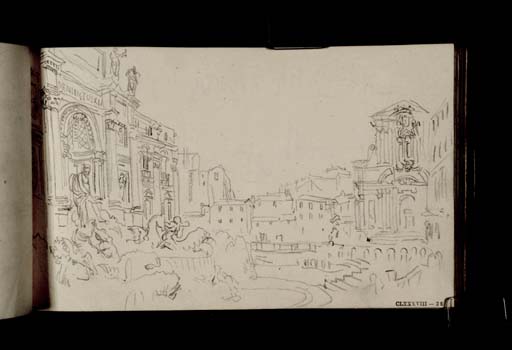Joseph Mallord William Turner The Trevi Fountain, Rome 1819
Image 1 of 2
Joseph Mallord William Turner,
The Trevi Fountain, Rome
1819
Joseph Mallord William Turner 1775–1851
Folio 27 Recto:
The Trevi Fountain, Rome 1819
D16204
Turner Bequest CLXXXVIII 26
Turner Bequest CLXXXVIII 26
Pencil on white wove paper, 114 x 189 mm
Inscribed by the artist in pencil ‘ECIT BENEDICTUS XIV’ along the frieze of the fountain
Stamped in black ‘CLXXXVIII 26’ bottom right
Stamped in black ‘CLXXXVIII 26’ bottom right
Accepted by the nation as part of the Turner Bequest 1856
References
1909
A.J. Finberg, A Complete Inventory of the Drawings of the Turner Bequest, London 1909, vol.I, p.559, as ‘the Fontana di Trevi’.
1984
Cecilia Powell, ‘Turner on Classic Ground: His Visits to Central and Southern Italy and Related Paintings and Drawings’, unpublished Ph.D thesis, Courtauld Institute of Art, University of London 1984, reproduced fig.41, as ‘The Fontana di Trevi’.
1987
Cecilia Powell, Turner in the South: Rome, Naples, Florence, New Haven and London 1987, p.38, reproduced p.[40] pl.38, as ‘The Fontana di Trevi’.
1996
Hardy George, ‘Turner, Lawrence, Canova and Venetian art’, Apollo, October 1996, pp.25, 26, reproduced fig.1.
1997
Anthony Bailey, Standing in the Sun: A Life of J.M.W. Turner, London 1997, p.244 note 6.
This sketch depicts a view of the famous Fontana di Trevi (Trevi Fountain), a large Baroque fountain built 1732–62 near the Quirinal Palace in Rome. Turner’s sketch takes an oblique angle to the west of the fountain looking across the basin. In the background to the right is the elaborate Baroque façade of the Church of Santi Vincenzo e Anastasio, built by Martino Longhi in 1650. The artist has partially recorded the commemorative inscription running in gold letters across the frieze near the top of the structure: ‘PERFECIT BENEDICTVS XIV PON. MAX.’ [Completed by Pope Benedictus XIV]. Cecilia Powell has noted the close similarity of this composition to Piranesi’s treatment of the same subject in the engraved series Veduta di Roma, (1748–78).1
Described by Turner’s friend, Samuel Rogers, as a ‘magnificent profusion of marble & water’, the Trevi Fountain was designed by Nicola Salvi (1697–1751) and completed in 1762.2 Based upon the format of a triumphal arch the design incorporated the fountain into the backdrop of the adjoining Palazzo Poli. Various sculptors added figures and decorative elements including the central group by Pietro Bacci (1700–1773) which shows Neptune in a shell chariot drawn by horses and tritons. Although it is today one of the most popular tourist spots in Rome, during the early nineteenth century the prevailing taste was for neoclassical architecture, and the theatrical decoration of the fountain was often perceived to be overly dramatic and excessive. The author Joseph Forsyth, for example, described it as ‘another pompous confusion of fable and fact, gods and ediles, aqueducts and sea-monsters’.3 Turner’s interest in this, and other Baroque monuments within the city, was therefore relatively unusual.4 One explanation, however, might be that he seems actually to have stayed at the Palazzo Poli during his sojourn in Rome. The palace was an established residence for artists during the period and a letter written by Turner on Saturday 27 November 1819 to the Italian sculptor, Antonio Canova, documents it as his address.5 Hardy George has suggested that this accommodation may have been arranged by Turner’s friend and fellow Royal Academician, the portrait painter Sir Thomas Lawrence (1769–1830).6 Lawrence was in Rome between May 1819 and January 1820, living at the Palazzo del Quirinale, and his role as an official envoy of the Prince Regent meant that he was well placed to introduce and assist Turner upon his arrival in the city.
Nicola Moorby
September 2008
Powell 1987, pp.38–40; see Luigi Ficacci, Piranesi: The Complete Etchings, Köln and London 2000, no.883, reproduced p.691.
How to cite
Nicola Moorby, ‘The Trevi Fountain, Rome 1819 by Joseph Mallord William Turner’, catalogue entry, September 2008, in David Blayney Brown (ed.), J.M.W. Turner: Sketchbooks, Drawings and Watercolours, Tate Research Publication, December 2012, https://www


